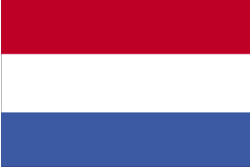Netherlands: Difference between revisions
imported>Eddie Ortiz Nieves (added image) |
imported>Robert Tito mNo edit summary |
||
| Line 5: | Line 5: | ||
The Netherlands is highly industrialized and one of the most densely populated countries in [[Europe]]. Its surface area is 41.528 km² (of which 18,41% is water) and its 2007 population is 16,570,613. This gives 489 inhabitants per km² of dry land. The capital of the country is [[Amsterdam]], while the government is seated in [[The Hague]]. | The Netherlands is highly industrialized and one of the most densely populated countries in [[Europe]]. Its surface area is 41.528 km² (of which 18,41% is water) and its 2007 population is 16,570,613. This gives 489 inhabitants per km² of dry land. The capital of the country is [[Amsterdam]], while the government is seated in [[The Hague]]. | ||
As of the 13th century The Netherlands were then known to be the ''United Seven Provinces'', that used Dutch as the official language in their communications and writings. | |||
The Netherlands was a [[republic]] from 1579 until 1806, when [[Napoleon Bonaparte]] appointed his brother as the first king of the Netherlands. After the [[Congress of Vienna]] in 1815, the country became a kingdom with [[William of Orange I]] as the first king. His descendant, [[Beatrix of Orange]], is now queen of the Netherlands. The country is a [[constitutional monarchy]] with a [[bicameral]] parliament, see [[Dutch constitution]]. It is a founding member of the [[European Economic Community]], which evolved into the present [[European Union]]. | The Netherlands was a [[republic]] from 1579 until 1806, when [[Napoleon Bonaparte]] appointed his brother as the first king of the Netherlands. After the [[Congress of Vienna]] in 1815, the country became a kingdom with [[William of Orange I]] as the first king. His descendant, [[Beatrix of Orange]], is now queen of the Netherlands. The country is a [[constitutional monarchy]] with a [[bicameral]] parliament, see [[Dutch constitution]]. It is a founding member of the [[European Economic Community]], which evolved into the present [[European Union]]. | ||
Revision as of 16:21, 18 October 2007
The Netherlands is a country that lies at the western end of the North European Plain, which extends to the Ural Mountains. Except for the southeastern part, the Netherlands is flat and about 40% of the country lies below sea level. The inhabitants of the Netherlands, called the Dutch, have built dykes to hold back the sea. The country is situated at the estuary of the river Rhine, which originates in Switzerland, and the river Meuse, which runs via Belgium from France to the city of Rotterdam, the main seaport of the Netherlands.
The Netherlands is highly industrialized and one of the most densely populated countries in Europe. Its surface area is 41.528 km² (of which 18,41% is water) and its 2007 population is 16,570,613. This gives 489 inhabitants per km² of dry land. The capital of the country is Amsterdam, while the government is seated in The Hague.
As of the 13th century The Netherlands were then known to be the United Seven Provinces, that used Dutch as the official language in their communications and writings. The Netherlands was a republic from 1579 until 1806, when Napoleon Bonaparte appointed his brother as the first king of the Netherlands. After the Congress of Vienna in 1815, the country became a kingdom with William of Orange I as the first king. His descendant, Beatrix of Orange, is now queen of the Netherlands. The country is a constitutional monarchy with a bicameral parliament, see Dutch constitution. It is a founding member of the European Economic Community, which evolved into the present European Union.
